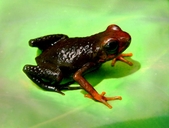|
Excidobates condor Almendáriz, Ron & Brito M., 2012
Condor Poison Frog | family: Dendrobatidae subfamily: Dendrobatinae genus: Excidobates |
| Species Description: Almendariz A, Ron SR, Brito J 2012 Una especie nueva de rana venenosa de altura del genero Excidobates (Dendrobatoidea: Dendrobatidae) de la Cordillera del Condor. Pap. Avulsos Zool (Sao Paulo) 52:387-399. | |
 © 2012 Ana Almendariz (1 of 4) |
|
|
|
Description Tadpoles have robust bodies with a total length at Gosner stage 35 of 32 mm and a body length of 6.4 mm (for measurements of tadpoles from stage 21 to 42, please see Almendáriz et al. 2012). The body is wider than high. The snout is rounded in the dorsal view. The eyes are dorsal. The oral disk is directed anteroventrally and is more than a third of the body width. There is a complete row of irregular papillae on the posterior lip, but none on the anterior lip, and a single lateral row. The labial teeth formula is 2 (2) / 3 (1) with A-1 being complete, A-2 having a medial gap, P-1 having a small medial gap, and P-2 being longer than P-3. The vent tube is free. In preservative, the mouth is visible at the body margin from the dorsal view. The long tail has musculature that is slightly taller than wide. The fins begin at the base of the tail (Almendáriz et al. 2012). DIAGNOSIS: Two species related to E. condor are E. captivus and E. mysteriosus. Adult E. condor can be distinguished from these species by the colorless, tubercular nature of the skin on its back and by the absence of large white spots on the ventral surface of the thighs. It can be further distinguished from E. mysteriosus by its smaller size and by its tendency to inhabit areas at higher altitudes than ones inhabited by E. mysteriosus (Almendáriz et al. 2012). Excidobates condor also closely resembles Andinobates abditus. However, E. condor females are larger than A. abditus females. Additionally, E. condor lacks the orange/yellow groins associated with A. abditus. Furthermore, E. condor possesses orange forearms that are absent in A. abditus (Almendáriz et al. 2012). COLORATION: In life, adult E. condor has a background color of black on the dorsal and ventral surfaces. The head in males is dark red from the anterior end of the upper jaw to the eye, while females possess all-black heads. The forearms are orange-brown from just above the elbows, with this coloration becoming most saturated on the hands. The ventral surfaces of the hands are orange, but the soles of the feet are black. The iris is black. In preserved adult specimens, the fingers and toes are light gray, while the rest of the body is dark gray (Almendáriz et al. 2012). Tadpoles, in life, are a uniform black on the dorsal surface while the belly is black with a metallic sheen. The fins are transparent. In preservative, the dorsum fades to light tan, the abdomen is black with a light median band at the mid-belly and a transparent tan periphery around the belly. The tail musculature becomes dark brown at the middle and dorsoventral direction but gray in the dorsal region. The fins are transparent gray (Almendáriz et al. 2012). VARIATION: The female specimen had an all-black head, while males possess dark red heads. Furthermore, the female is somewhat larger than the males (Almendáriz 2012). Distribution and Habitat Country distribution from AmphibiaWeb's database: Ecuador
Life History, Abundance, Activity, and Special Behaviors Adult specimens were collected in the afternoon and found at the base of trees and bromeliads, or in roots, leaf litter, and moss that cover a sandstone substrate. Adults are difficult to find and these locations may provide cryptic refugia (Almendáriz et al. 2012). Excidobates condor undergoes indirect development and tadpoles can be found in collections of water at the base of bromeliads from the genus Guzmania (Almendáriz et al. 2012). Trends and Threats Possible reasons for amphibian decline General habitat alteration and loss Comments PHYLOGENETIC RELATIONSHIPS: The genus Excidobates is in the family Dendrobatidae and a sister group to Andinobates and Ranitomeya. Maximum Likelihood analysis of mitochondrial genes 12S and 16S rRNA, indicate that E. condor is sister to E. mysteriosus and together they are sister to E. captivus (Almendáriz et al. 2012). As of 2022, these are the only three species in the genus. ETYMOLOGY: The species epithet “condor” was inspired by the region where the frogs are found, specifically, the mountain range in Ecuador called the Cordillera del Cóndor (Almendáriz et al. 2012).
References
Almendáriz, A. C., Ron, S. R., Brito, J. M. (2012). “Una especie nueva de rana venenosa de altura del género Excidobates (Dendrobatoidea: Dendrobatidae) de la Cordillera del Cóndor.” Papéis Avulsos de Zoologia, 52(32), 387-399. [link] Almendáriz, A., Simmons, J.E., Brito, J., Vaca-Guerrero, J. (2014). “Overview of the herpetofauna of the unexplored Cordillera del Cóndor of Ecuador.” Amphibian and Reptile Conservation 8(1), 45-64. [link] IUCN SSC Amphibian Specialist Group. (2019). "Excidobates condor". The IUCN Red List ofThreatened Species 2019: e.T78500583A98658744. http://dx.doi.org/10.2305/IUCN.UK.2019-3.RLTS.T78500583A98658744.en Originally submitted by: Adrian Gutierrez, Alicia Hernandez, Thomas Phillips (2022-05-11) Description by: Adrian Gutierrez, Alicia Hernandez, Thomas Phillips (updated 2022-05-11)
Distribution by: Adrian Gutierrez, Alicia Hernandez, Thomas Phillips (updated 2022-05-11)
Life history by: Adrian Gutierrez, Alicia Hernandez, Thomas Phillips (updated 2022-05-11)
Trends and threats by: Adrian Gutierrez, Alicia Hernandez, Thomas Phillips (updated 2022-05-11)
Comments by: Adrian Gutierrez, Alicia Hernandez, Thomas Phillips (updated 2022-05-11)
Edited by: Ann T. Chang (2022-05-11) Species Account Citation: AmphibiaWeb 2022 Excidobates condor: Condor Poison Frog <https://amphibiaweb.org/species/7915> University of California, Berkeley, CA, USA. Accessed May 9, 2025.
Feedback or comments about this page.
Citation: AmphibiaWeb. 2025. <https://amphibiaweb.org> University of California, Berkeley, CA, USA. Accessed 9 May 2025. AmphibiaWeb's policy on data use. |


 Map of Life
Map of Life